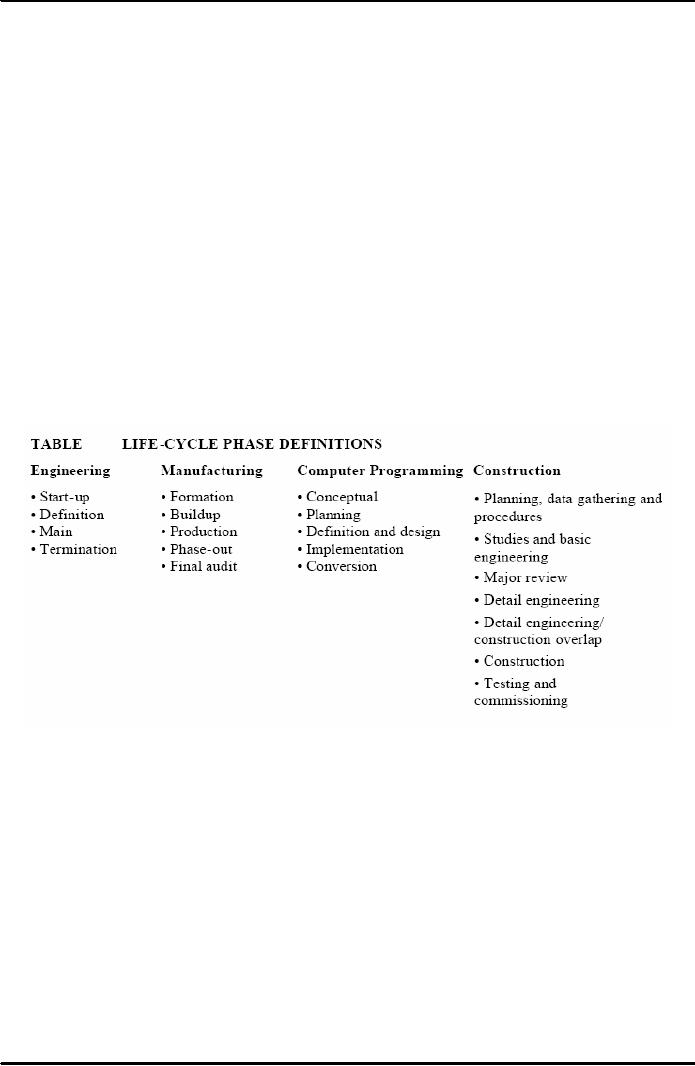 |

Project
Management MGMT627
VU
LESSON
20
PROJECT
PLANNING (CONTD.)
Broad
Contents
Life
Cycle Phases
Responsibilities
of Key Players
Problems
in Objective Setting
20.1
Life-Cycle
Phases:
To
describe it further, project
planning takes place at two
levels. The first level is
the corporate
cultural
approach; the second method is the individual's
approach. The corporate cultural
approach
breaks the project down into
life-cycle phases, such as
those shown in Table 20.1.
The
life-cycle
phase approach is not
an
attempt to put handcuffs on the project
manager but to
provide
a methodology for uniformity in
project planning. Many
companies, including
government
agencies, prepare checklists of activities
that should be considered in each
phase.
These
checklists are for consistency in
planning. The project
manager can still exercise
his own
planning
initiatives within each
phase.
Table
20.1: Life-Cycle
Phase Definitions
In
addition to this, the second
benefit of life-cycle phases is
control. At the end of each
phase
there
is a meeting between the project manager, sponsor,
senior management, and even the
customer,
to assess the accomplishments of this
life-cycle phase and to get approval
for the next
phase.
These meetings are often
called critical design reviews,
"on-off ramps," and "gates." In
some
companies, these meetings are
used to firm up budgets and
schedules for the
follow-on
phases.
In addition to monetary considerations,
life-cycle phases can be
used for manpower
deployment
and equipment/facility utilization. Some
companies go so far as to prepare
project
management
policy and procedure manuals where
all information is subdivided
according to
life-cycle
phasing. Life-cycle phase decision
points eliminate the problem where
project
managers
do not ask for phase
funding, but rather ask for
funds for the whole project
before the
true
scope of the project is known. Several
companies have even gone so far as to
identify the
types
of decisions that can be made at
each end-of-phase review meeting.
They include:
·
Proceed
with the next phase based on
an approved funding
level
·
Proceed
to the next phase but with a
new or modified set of
objectives
144

Project
Management MGMT627
VU
·
Postpone
approval to proceed based on a
need for additional
information
·
Terminate
project
For
instance, consider a company that
utilizes the following life-cycle
phases:
·
Conceptualization
·
Feasibility
·
Preliminary
planning
·
Detail
planning
·
Execution
·
Testing
and commissioning
As
the name suggests, the conceptualization
phase includes brainstorming and common
sense
and
involves two critical
factors:
1.
Identify and define the problem,
and
2.
Identify and define potential
solutions
All
ideas
are recorded and none are discarded in a
brainstorming session. The
brainstorming
session
works best if there is no formal
authority present and if the time
duration is no more
than
thirty to sixty minutes. Sessions
over sixty minutes in length
will produce ideas that
may
begin
to resemble science
fiction.
The
second phase, that is the
feasibility study phase,
considers the technical aspects of
the
conceptual
alternatives and provides a firmer
basis on which to decide whether to
undertake the
project.
Note
that the purpose of the feasibility
phase is to:
·
Plan
the project development and
implementation activities.
·
Estimate
the probable elapsed time,
staffing, and equipment
requirements.
·
Identify
the probable costs and consequences of
investing in the new
project.
If
practical, the feasibility study
results should evaluate the
alternative conceptual solutions
along
with associated benefits and
costs. The objective of this
step is to provide
management
with
the predictable results of implementing a
specific project and to provide
generalized
project
requirements. This, in the form of a
feasibility study report, is
used as the basis on
which
to
decide whether to proceed with the
costly requirements, development, and
implementation
phases.
Moving
ahead with the life-cycle, the
third life-cycle phase is
either preliminary planning
or
''defining
the requirements." This is the phase
where the effort is officially
defined as a project.
In
this phase, we should consider the
following:
·
General
scope of the work
·
Objectives
and related background
·
Contractor's
tasks
·
Contractor
end-item performance requirements
·
Reference
to related studies, documentation,
and specifications
·
Data
items (documentation)
·
Support
equipment for contract
end-item
·
Customer-furnished
property, facilities, equipment, and
services
·
Customer-furnished
documentation
·
Schedule
of performance
·
Exhibits,
attachments, and appendices
145

Project
Management MGMT627
VU
20.2
Responsibilities
of Key Players:
We
know that planning simply
does not happen by itself. Companies
that have histories of
successful
plans also have employees who fully
understand their roles in the planning
process. Good
up-front
planning may not eliminate
the need for changes, but
may reduce the number of
changes
required.
The responsibilities of the major
players are as
follows:
1.
Project
manager will define:
·
Goals
and objectives
·
Major
milestones
·
Requirements
·
Ground
rules and assumptions
·
Time,
cost, and performance constraints
·
Operating
procedures
·
Administrative
policy
·
Reporting
requirements
2.
Line
manager will define:
·
Detailed
task descriptions to implement
objectives, requirements, and milestones
·
Detailed
schedules and manpower allocations to support
budget and schedule
·
Identification
of areas of risk, uncertainty, and
conflict
3.
Senior
management (project sponsor)
will:
·
Act
as the negotiator for disagreements
between project and line
management
·
Provide
clarification of critical
issues
·
Provide
communication link with
customer's senior management
Remember
that successful planning requires
that project, line, and senior
management are in
agreement
with the plan.
20.3
Problems
in Objective Setting:
It
is not possible to satisfy all
objectives every time. At
this point, management must
prioritize
the
objectives as to which are strategic
and which are not.
Typical problems with
developing
objectives
include:
·
Project
objectives/goals are not
agreeable to all parties.
·
Project
objectives are too rigid to
accommodate changing
·
Insufficient
time exists to define objectives
well.
·
Objectives
are not adequately
quantified.
·
Objectives
are not documented well
enough.
·
Efforts
of client and project personnel are
not coordinated.
·
Personnel
turnover is high.
146
Table of Contents:
- INTRODUCTION TO PROJECT MANAGEMENT:Broad Contents, Functions of Management
- CONCEPTS, DEFINITIONS AND NATURE OF PROJECTS:Why Projects are initiated?, Project Participants
- CONCEPTS OF PROJECT MANAGEMENT:THE PROJECT MANAGEMENT SYSTEM, Managerial Skills
- PROJECT MANAGEMENT METHODOLOGIES AND ORGANIZATIONAL STRUCTURES:Systems, Programs, and Projects
- PROJECT LIFE CYCLES:Conceptual Phase, Implementation Phase, Engineering Project
- THE PROJECT MANAGER:Team Building Skills, Conflict Resolution Skills, Organizing
- THE PROJECT MANAGER (CONTD.):Project Champions, Project Authority Breakdown
- PROJECT CONCEPTION AND PROJECT FEASIBILITY:Feasibility Analysis
- PROJECT FEASIBILITY (CONTD.):Scope of Feasibility Analysis, Project Impacts
- PROJECT FEASIBILITY (CONTD.):Operations and Production, Sales and Marketing
- PROJECT SELECTION:Modeling, The Operating Necessity, The Competitive Necessity
- PROJECT SELECTION (CONTD.):Payback Period, Internal Rate of Return (IRR)
- PROJECT PROPOSAL:Preparation for Future Proposal, Proposal Effort
- PROJECT PROPOSAL (CONTD.):Background on the Opportunity, Costs, Resources Required
- PROJECT PLANNING:Planning of Execution, Operations, Installation and Use
- PROJECT PLANNING (CONTD.):Outside Clients, Quality Control Planning
- PROJECT PLANNING (CONTD.):Elements of a Project Plan, Potential Problems
- PROJECT PLANNING (CONTD.):Sorting Out Project, Project Mission, Categories of Planning
- PROJECT PLANNING (CONTD.):Identifying Strategic Project Variables, Competitive Resources
- PROJECT PLANNING (CONTD.):Responsibilities of Key Players, Line manager will define
- PROJECT PLANNING (CONTD.):The Statement of Work (Sow)
- WORK BREAKDOWN STRUCTURE:Characteristics of Work Package
- WORK BREAKDOWN STRUCTURE:Why Do Plans Fail?
- SCHEDULES AND CHARTS:Master Production Scheduling, Program Plan
- TOTAL PROJECT PLANNING:Management Control, Project Fast-Tracking
- PROJECT SCOPE MANAGEMENT:Why is Scope Important?, Scope Management Plan
- PROJECT SCOPE MANAGEMENT:Project Scope Definition, Scope Change Control
- NETWORK SCHEDULING TECHNIQUES:Historical Evolution of Networks, Dummy Activities
- NETWORK SCHEDULING TECHNIQUES:Slack Time Calculation, Network Re-planning
- NETWORK SCHEDULING TECHNIQUES:Total PERT/CPM Planning, PERT/CPM Problem Areas
- PRICING AND ESTIMATION:GLOBAL PRICING STRATEGIES, TYPES OF ESTIMATES
- PRICING AND ESTIMATION (CONTD.):LABOR DISTRIBUTIONS, OVERHEAD RATES
- PRICING AND ESTIMATION (CONTD.):MATERIALS/SUPPORT COSTS, PRICING OUT THE WORK
- QUALITY IN PROJECT MANAGEMENT:Value-Based Perspective, Customer-Driven Quality
- QUALITY IN PROJECT MANAGEMENT (CONTD.):Total Quality Management
- PRINCIPLES OF TOTAL QUALITY:EMPOWERMENT, COST OF QUALITY
- CUSTOMER FOCUSED PROJECT MANAGEMENT:Threshold Attributes
- QUALITY IMPROVEMENT TOOLS:Data Tables, Identify the problem, Random method
- PROJECT EFFECTIVENESS THROUGH ENHANCED PRODUCTIVITY:Messages of Productivity, Productivity Improvement
- COST MANAGEMENT AND CONTROL IN PROJECTS:Project benefits, Understanding Control
- COST MANAGEMENT AND CONTROL IN PROJECTS:Variance, Depreciation
- PROJECT MANAGEMENT THROUGH LEADERSHIP:The Tasks of Leadership, The Job of a Leader
- COMMUNICATION IN THE PROJECT MANAGEMENT:Cost of Correspondence, CHANNEL
- PROJECT RISK MANAGEMENT:Components of Risk, Categories of Risk, Risk Planning
- PROJECT PROCUREMENT, CONTRACT MANAGEMENT, AND ETHICS IN PROJECT MANAGEMENT:Procurement Cycles